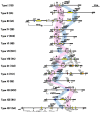Current Status of Staphylococcal Cassette Chromosome mec (SCC mec)
- PMID: 35052963
- PMCID: PMC8772726
- DOI: 10.3390/antibiotics11010086
Current Status of Staphylococcal Cassette Chromosome mec (SCC mec)
Abstract
Staphylococcal cassette chromosome mec (SCCmec) typing was established in the 2000s and has been employed as a tool for the molecular epidemiology of methicillin-resistant Staphylococcus aureus, as well as the evolution investigation of Staphylococcus species. Molecular cloning and the conventional sequencing of SCCmec have been adopted to verify the presence and structure of a novel SCCmec type, while convenient PCR-based SCCmec identification methods have been used in practical settings for many years. In addition, whole-genome sequencing has been widely used, and various SCCmec and similar structures have been recently identified in various species. The current status of the SCCmec types, SCCmec subtypes, rules for nomenclature, and multiple methods for identifying SCCmec types and subtypes were summarized in this review, according to the perspective of the International Working Group on the Classification of Staphylococcal Cassette Chromosome Elements.
Keywords: International Working Group on the Classification of Staphylococcal Cassette Chromosome Elements; SCCmec subtyping; SCCmec typing; methicillin-resistant Staphylococcus aureus; staphylococcal cassette chromosome mec (SCCmec).
Conflict of interest statement
The authors declare no conflict of interest.
Figures





References
-
- Jevons M.P. “Celbenin”—Resistant Staphylococci. Br. Med. J. 1961;1:124–125. doi: 10.1136/bmj.1.5219.124-a. - DOI
-
- Centers for Disease Control and Prevention Brief History of Resistance and Antibiotics. [(accessed on 14 December 2021)]; Available online: https://www.cdc.gov/drugresistance/about.html#anchor_1552062951754.
-
- Horner C., Mushtaq S., Allen M., Longshaw C., Reynolds R., Livermore D.M. Are resistance rates among bloodstream isolates a good proxy for other infections? Analysis from the BSAC resistance surveillance programme. J. Antimicrob. Chemother. 2021;76:1822–1831. doi: 10.1093/jac/dkab096. - DOI - PubMed
-
- Centers for Disease Control and Prevention (CDC) Antibiotic/ Antimicrobial Resistance (AR/AMR) U.S. Nation Action Plan. [(accessed on 1 January 2022)];2013 Available online: https://www.cdc.gov/drugresistance/us-activities/national-action-plan.html.
Publication types
LinkOut - more resources
Full Text Sources

